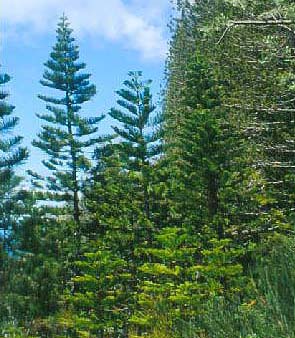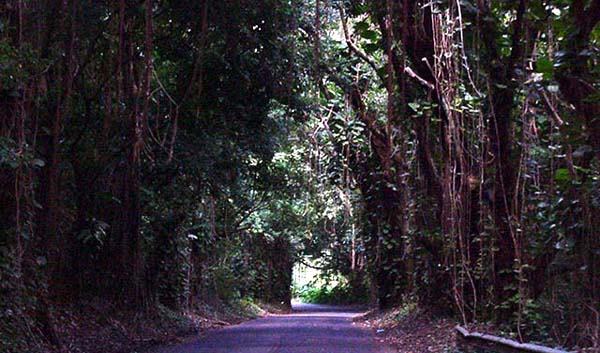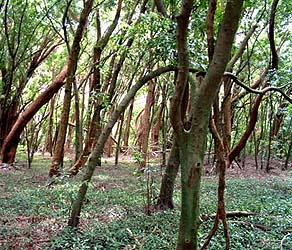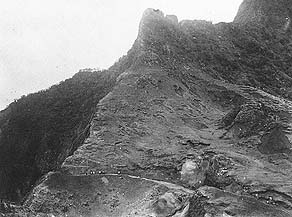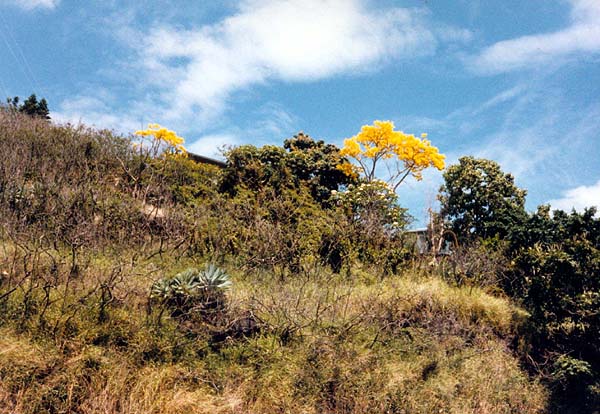 |
 |
 |
|||||||||||||||||||||
|
|
|
|
|
|
|
|
|
||||||||||||||||
|
|
|||||||||||||||||||||||
|
|
|
|
A forest of introduced species near the Pali lookout: attractive, but alien.
|
|
|
The lush foliage of cool Nu‘uanu suggests that the existing forest is a native Hawaiian ecosystem. But this could not be farther from the truth. Generally, the lower-elevation vegetation throughout the Hawaiian Islands has been destroyed and replaced by introduced species, and the middle elevations are only semi-intact. There are various reasons for this: introduced species tend to be hardier and more aggressive. They spread more easily, and crowd out native species. But also Nu‘uanu, being so close to the developing urban center of Honolulu, was quickly deforested for timber and fuelwood to supply passing ships.
|
||
|
|
||
|
|
The impact of cattle introduced by Vancouver is a third reason. Stephen remarks, "When the Europeans arrived they brought gifts of cattle. The cattle were released and because there was a kapu placed, you couldn't kill the cattle because they were the gifts to the King. Cattle were all up in the forest devastating a lot of the new growth. "Finally in the late 1880s, King Kalakaua started a reforestation project back here to try to replant. There were conscious forestation projects in the 1930s as well, with active planting of alien trees. The trees you see now are mostly alien. There are some native koa, but all the other kinds, well, we call them trash."
|
"We really don’t see natural forests here in this valley because wherever the Western forestry program came in, the alien trees have pretty much spread out." Reforestation, Stephen suggests, has been a part of the problem rather than a part of the solution. "The birds are also a big factor here in transporting seeds and pods like the ironwood trees. They were planted largely on the coastline, but you see them all the way up in the mountains. And the birds carry them."
|
|
|
|
|
|
| Would upper Nu‘uanu have been naturally very lush in in the past? Not with the type of forest it has today, Stephen says, with a complete canopy over the top. "You would have had the koa (one of the taller trees), the ‘ohi‘a, the lauhala trees, kukui nut trees, the hau bush. But the main difference was the presence of the low understory—the ferns—and that’s what's missing here. When you have a thick canopy, there’s no sunlight penetration to keep the understory thriving. That’s the problem with the alien trees: they eventually take over and overshadow; they steal the water and the sunlight."
|
||
|
||
|
"That’s the problem at Kaniakapupu: the place is overgrown. We know there was a house site, we know there was a heiau, we know there were taro ponds, and you can’t grow taro without sun, so that’s the other reason I say we know the forests were not a prominent part of the landscape, because wherever you saw taro patches, it was open to sunlight and rain." "It’s new growth," Kalani agrees. "I remember there being a forest area and a larger area with less homes. In the area where there were no homes, it was tall grass and ferns. Some trees, not many. The trees that came in were always mango trees or kukui nut trees. There were more of those."
|
|
|
|
|
Two major pests include bamboo, and banyan trees. "Bamboo is a pest," Stephen remarks. "Some of it is native, but a lot of it was introduced. A lot of it is by accident." Kalani concurs that there wasn’t as much back in her childhood as there is now. And while the original Polynesian colonizers brought one species of bamboo, that is not the voracious type we are seeing today. "The banyan trees are awful and totally invasive and that’s new," she adds. "Unfortunately, I guess the City thinks they were here all the time, so they don’t cut them down. They have caused a great deal of damage." "Banyans will eventually take over," Stephen adds. "You can see the evidence of that taking place.They are alien trees, their root systems are very invasive, they get in, and they can actually start tumbling rocks down."
|
|
|
What about up near the Pali lookout? "We know there was an artillery duel actually going on here during the battle of Nu‘uanu," Stephen replies. "When you read about Civil War history you hear about how important the open field of fire was for artillery units. Often times the army had to cut down trees to set up the range for their artilleries-- artilleries are no good in forests. You see all the trees here now, well, these trees weren’t here, or you wouldn’t have had an artillery duel. "We call this a 'water reserve' but it’s really not functioning that way. They’re using a forestry technique that was for the continent, and is really destroying our basic water supply. Look at how much these trees are thriving. These trees are stealing the water that should be going into the ground, into the aquifers. Anybody who knows a little bit about plants, you know the plant thrives when it has plenty of water." |
|
|
|
|
|
|
"These trees have root systems that go deep into the ground. We know from that from the botanists. And we know that Hawaiian native plants have mostly shallow root systems. Remember how they evolved: this is a volcanic island. The plants that thrived here were those that developed shallow roots that would spread out over the eroded volcanic material, and utilize the thin layers of nutrients that built up over time. These continental trees, like kiawe (mesquite)--it's the notorious alien plant brought in by the cattle ranchers. These are essentially desert plants, so they have tap roots that can go 100 feet down. That’s why when we have a drought, you see that the alien trees are not suffering."
|
||
|
|
||
| |
| |
|
|
 |
| Nu‘uanu Home | Map Library | Site Map | Hawaiian Islands Home | Pacific Worlds Home |
|
|
|||
| Copyright 2003 Pacific Worlds & Associates • Usage Policy • Webmaster |
|||

